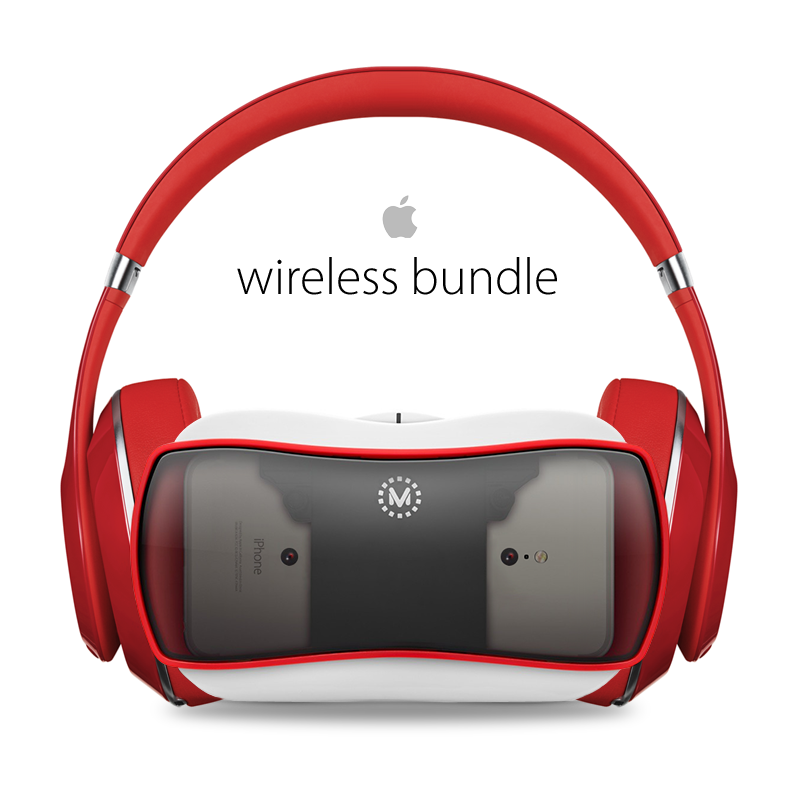Apple & VR
 Tuesday, February 9, 2016 at 11:00PM
Tuesday, February 9, 2016 at 11:00PM  In 1919 an entrepreneur named Edwin Eugene Mayer purchased a local Portland, Oregon photofinishing shop named Sawyer’s, and grew the company into a national distributor of tourist postcards. Mayer sought a senior executive to run sales and marketing while he focused on operations, and in 1926 he brought in Harold Graves who became the company’s president. One very popular form of tourist postcard was the stereogram, viewed with a Victorian device known as a stereoscope, that allowed these split frame still photos to be viewed in 3D. Stereoscopic cards of tourist attractions were already part of Sawyer’s postcard business, and Graves begun experimenting with different camera rigs
In 1919 an entrepreneur named Edwin Eugene Mayer purchased a local Portland, Oregon photofinishing shop named Sawyer’s, and grew the company into a national distributor of tourist postcards. Mayer sought a senior executive to run sales and marketing while he focused on operations, and in 1926 he brought in Harold Graves who became the company’s president. One very popular form of tourist postcard was the stereogram, viewed with a Victorian device known as a stereoscope, that allowed these split frame still photos to be viewed in 3D. Stereoscopic cards of tourist attractions were already part of Sawyer’s postcard business, and Graves begun experimenting with different camera rigs 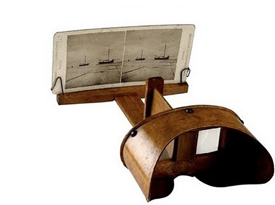 and custom stereoscopic devices to distinguish Sawyer’s in the market. At this time a local inventor named William Gruber pitched Sawyer’s on a superior device. Gruber had mounted two 16mm Kodak cameras, side-by-side on a tripod. This itself was not that unique, but rather than processing the photos as prints and viewing them with a stereoscope, Gruber instead used Kodachrome color transparency film. He would take the usual stereoscopic pairs but process them as 16mm color slides, then affix them in a card mounting, and view them through a specialized binocular apparatus. The results were superior to anything Graves or Mayer had seen, and they began negotiation a deal to bring Gruber into the business.
and custom stereoscopic devices to distinguish Sawyer’s in the market. At this time a local inventor named William Gruber pitched Sawyer’s on a superior device. Gruber had mounted two 16mm Kodak cameras, side-by-side on a tripod. This itself was not that unique, but rather than processing the photos as prints and viewing them with a stereoscope, Gruber instead used Kodachrome color transparency film. He would take the usual stereoscopic pairs but process them as 16mm color slides, then affix them in a card mounting, and view them through a specialized binocular apparatus. The results were superior to anything Graves or Mayer had seen, and they began negotiation a deal to bring Gruber into the business.
 In 1939 the View-Master prototype was unveiled at the New York World’s Fair, later to be introduced in the consumer market through Sawyer’s tourist postcard business in 1942, sold in the gift shops of tourist attractions both large and small. The real money was made not from selling the View-Master device, but from selling the reels of 3D images.
In 1939 the View-Master prototype was unveiled at the New York World’s Fair, later to be introduced in the consumer market through Sawyer’s tourist postcard business in 1942, sold in the gift shops of tourist attractions both large and small. The real money was made not from selling the View-Master device, but from selling the reels of 3D images.
Likewise, some of the biggest winners in virtual reality will not be the device makers with the most sophisticated hardware, but the creators who produce the virtual reality content. These content creators will be the kingmakers of the hardware platforms.
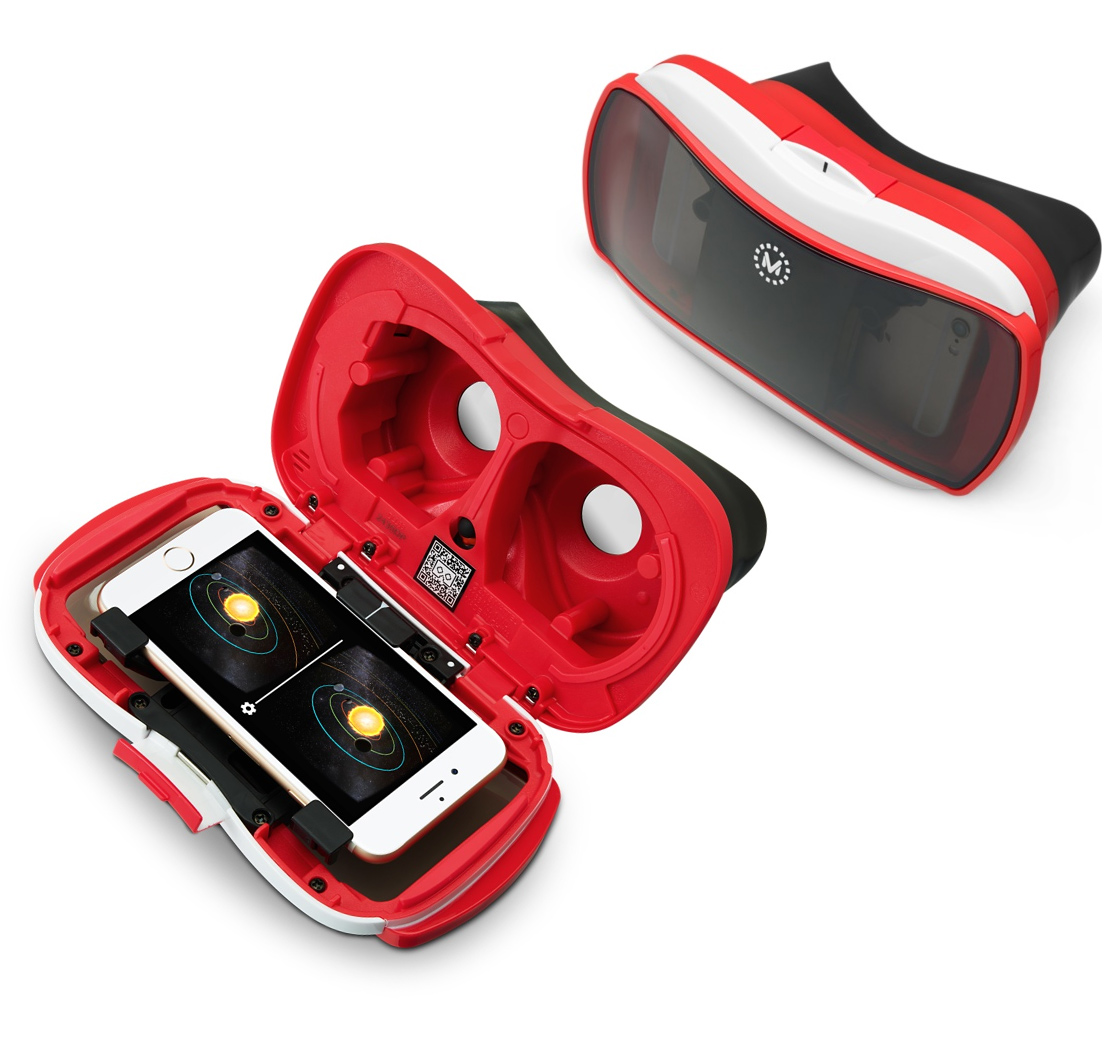
Today, in an era when every traveler has a smartphone in their pocket, tourist don’t buy photo postcards, they take their own. And the world’s most popular camera is the Apple iPhone.
It has long been my contrarian forecast that mass VR adoption will not come through games, but through virtual tourism and shared experiences. View-Master is the perfect analogy.
Just like a classic View-Master, for most users VR will not be experienced through hours-and-hours of wearing a face mounted display, but in brief shared moments, often personal in nature: a child’s birthday from afar. A friend’s trip to Taj Mahal. Most shorter in length than a music video — brief shared moments, seen through another’s eyes. Just like a classic View-Master, the View-Master VR does not have a head-strap, it is handheld. This is not what hardcore gamers are looking for, but most people will not become hardcore gamers. However, most people do take and share photos with their smartphone.
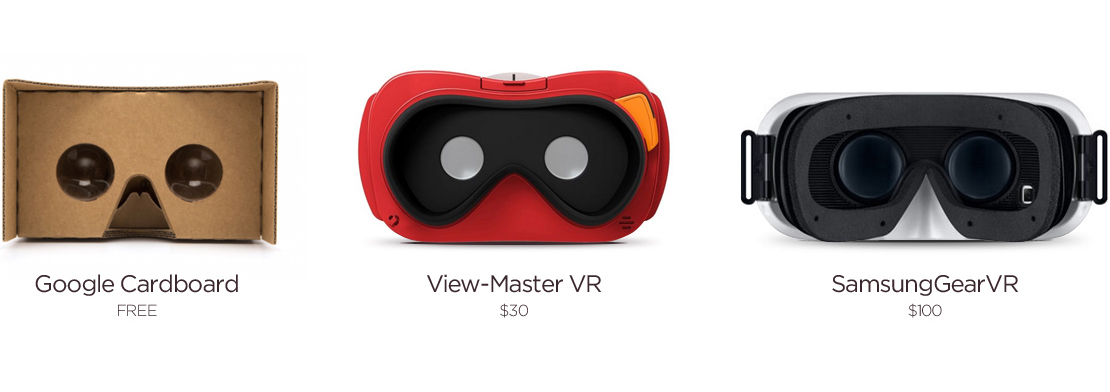
I also expect this kind of VR to be fixed-vantage-point. While low-latency head tracking is one of the principle technological hurdles that the newest VR headsets are specifically designed to solve, it is also the cause of VR nausea, and it is not needed for fixed-vantage-point stereoscopic videography.
There are some who say Apple is too late to the VR game. Those pundits all believe VR is just that, a game. On the other hand, Apple has a secret weapon: an installed base of iPhone users that upgrade more frequently than the users of any other handset maker. If every new iPhone were suddenly a stereoscopic camera, then Apple would lead the world’s largest tribe of user-generated VR content creators.
Further, to insinuate that Apple has just now jumped on the VR (or AR) bandwagon is a mischaracterization. Apple has been active in the Virtual Reality and Augmented Reality space going back to at least the 90s, with multiple patent filings on HMD designs predating their early 2015 patent, including these from 2012, and 2008 (I once built an animation of this patent for a lecture I gave in 2010.). In the 90s Apple even had a 360º Virtual Reality development platform, QuickTimeVR, that was a casualty of cost-cutting measures in the late 90s.
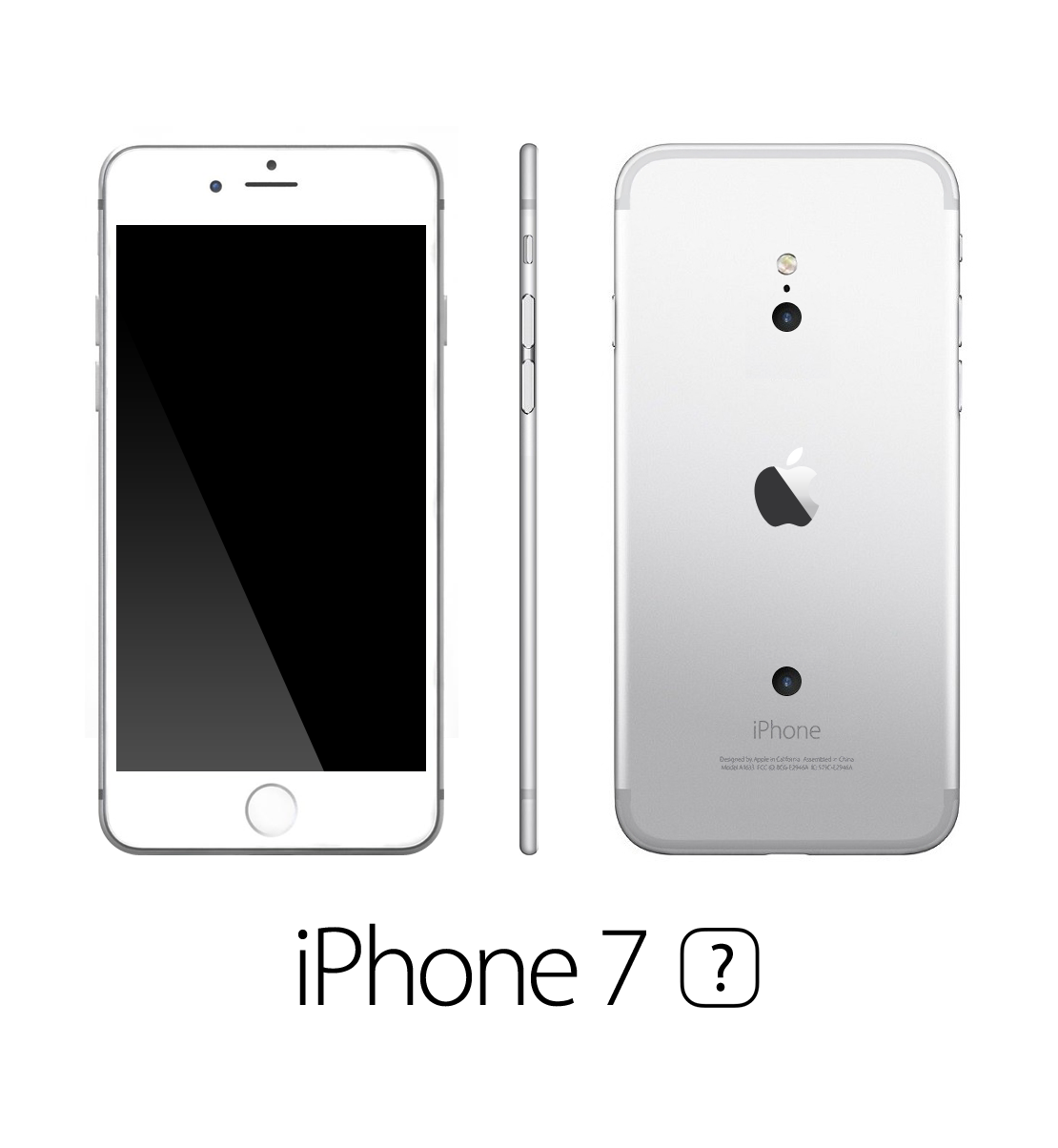
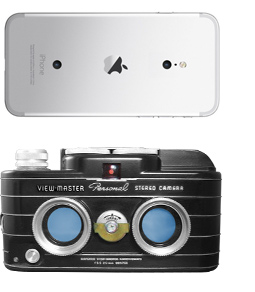 The iPhone 7 concept shown here is within the parameters of known leaks: Apple is obsessed as always with making each iPhone a little thinner. The iPhone 6 & 6s (both regular and plus models) current thickness is limited by the diameter of the headphone jack. There have been rumors out of China that the iPhone 7 will be both thinner, and include wireless headphones, sans a need for a headphone jack. Leaks have shown that the antenna band will be simplified, loosing one bisecting white-line on the top and bottom. Early last year Apple acquired LinX of Israel, who have developed a dual lens technology that improves optical zoom capabilities through the use of a pair of astonishingly small lenses, used in a pair. Apple has also recently been awarded a patent on various functionalities of this double-camera configuration. While the ostensible features covered in the patent pertain to the zoom len capabilities, and multitasking (one camera taking still photos while the other shoots video, etc.), there is nothing that would preclude this configuration from also taking stereoscopic photographs … except that the typical configuration shows them as adjacent paired lenses. That configuration would not be useful for stereoscopic photography and/or video. In order to produce the correct parallax effect, the cameras need to be a comparable distance apart to that of a typical pair of human eyes (as shown on the iPhone 7 concept above). While stereoscopy requires the separation, nothing I’ve read thus far says the LinX technology requires them to be close together. One caveat: Sony’s CFO, Kenichiro Yoshida, has speculated that the available components and production capacity won’t be online for Apple to do this until 2017 (Sony is a manufacturing contractor of cameras used in many models of Apple’s iPhone), so it could be delayed and available as a 7s feature (Note: Kenichiro was speaking of two-lens zoom technology, not two lens stereoscopic). That timeline is disappointing, but it does leave room for 3rd parties to test the market with stereoscopic attachments and accessories.
The iPhone 7 concept shown here is within the parameters of known leaks: Apple is obsessed as always with making each iPhone a little thinner. The iPhone 6 & 6s (both regular and plus models) current thickness is limited by the diameter of the headphone jack. There have been rumors out of China that the iPhone 7 will be both thinner, and include wireless headphones, sans a need for a headphone jack. Leaks have shown that the antenna band will be simplified, loosing one bisecting white-line on the top and bottom. Early last year Apple acquired LinX of Israel, who have developed a dual lens technology that improves optical zoom capabilities through the use of a pair of astonishingly small lenses, used in a pair. Apple has also recently been awarded a patent on various functionalities of this double-camera configuration. While the ostensible features covered in the patent pertain to the zoom len capabilities, and multitasking (one camera taking still photos while the other shoots video, etc.), there is nothing that would preclude this configuration from also taking stereoscopic photographs … except that the typical configuration shows them as adjacent paired lenses. That configuration would not be useful for stereoscopic photography and/or video. In order to produce the correct parallax effect, the cameras need to be a comparable distance apart to that of a typical pair of human eyes (as shown on the iPhone 7 concept above). While stereoscopy requires the separation, nothing I’ve read thus far says the LinX technology requires them to be close together. One caveat: Sony’s CFO, Kenichiro Yoshida, has speculated that the available components and production capacity won’t be online for Apple to do this until 2017 (Sony is a manufacturing contractor of cameras used in many models of Apple’s iPhone), so it could be delayed and available as a 7s feature (Note: Kenichiro was speaking of two-lens zoom technology, not two lens stereoscopic). That timeline is disappointing, but it does leave room for 3rd parties to test the market with stereoscopic attachments and accessories.
 Once the hardware is in place, live mobile streaming VR will be a thing. It is coming. I’ve spent the past year evangelizing that platforms like Periscope, Meerkat and more recently MeVee, should offer stereoscopic support. I speculate that Apple will (or should) build (or acquire) their own live video & stereoscopic VR streaming platform (perhaps built on top of FaceTime’s platform.).
Once the hardware is in place, live mobile streaming VR will be a thing. It is coming. I’ve spent the past year evangelizing that platforms like Periscope, Meerkat and more recently MeVee, should offer stereoscopic support. I speculate that Apple will (or should) build (or acquire) their own live video & stereoscopic VR streaming platform (perhaps built on top of FaceTime’s platform.).
On Apple’s recent earnings call, Tim Cook said of Virtual Reality, “I don’t think it’s a niche … it’s really cool and has some interesting applications.” Separately he also let it be known that he is shopping, stating that, “the downside of some economic stress is that some asset prices get cheaper, commodity prices get cheaper, and that sort of thing. So I think this is exactly the period that you want to invest and do so confidently.” So Apple is interested in VR in general, and is also in the market for deals.
In recent years Apple has made some noteworthy technology acquisitions in the AR and VR space, as well as recent hires. In 2013 they acquired PrimeSense of Israel, whose technology was licensed by Microsoft as the core of their Kinect device for XBox. Last year they acquired both Faceshift of Switzerland, and Germany’s Metaio. They’ve put together a good package of hardware sensors and computer vision software. Most recently they acquired Flyby Media of New York (previously known as Ogmento, founded by my friend and mentor, Ori Inbar). In the last six months they’ve also made a key AR hire, Nick Thompson, a leading technologist poached from Microsoft’s HoloLens team, and Douglas Bowman, formerly the Director of the Center for Human-Computer Interaction, at Virginia Tech.
If I were Apple, I’d be taking a close look at DigiLens, not for their recent motorcycle helmet, but more generally for both their waveguide technology, and to add Jonathan Waldern to their team. I have no information to suggest any such deal, though a company with DigiLens’ waveguide IP would nicely round-out Apple’s AR portfolio, bringing more than just Jonathan’s acquihire.
 While the flirtation with View-Master could be tactical and short term, it should not be discounted for a possible acquisition target. The View-Master brand is iconic, and known the world over — there’s not a company in the VR space that has that kind of brand recognition. Acquiring the View-Master brand for consumer grade VR devices would be a smart move on Apple’s part. Few technology companies would consider such an acquisition. Silicon Valley culture typically vastly underestimates brand value, and focuses solely on core technology. Further, acquiring the View-Master brand would not necessarily require the acquisition of Mattel. View-Master has a long history of spins-offs, acquisitions and ownership changes: It first changed hands in 1966 when Sawyer’s spun it off in a sale to General Aniline & Film (GAF), who in turn sold off the View-Master division to a group of investors headed by Arnold Thaler in 1981. By 1989 the View-Master brand was acquired again, this time by Tyco Toys. In 1997 Tyco was acquired by Mattel, bringing the View-Master brand along with the deal. In the oughts View-Master was placed in their Fisher-Price division, another Mattel acquisition. With the world’s largest private cash reserves, acquiring the View-Master brand away from Mattel would be peanuts for Apple. 2014’s Beats acquisition shows that Apple is willing to make brand acquisitions, in addition to core technology acquisitions, and View-Master would be a good fit in their small stable of iconic brands.
While the flirtation with View-Master could be tactical and short term, it should not be discounted for a possible acquisition target. The View-Master brand is iconic, and known the world over — there’s not a company in the VR space that has that kind of brand recognition. Acquiring the View-Master brand for consumer grade VR devices would be a smart move on Apple’s part. Few technology companies would consider such an acquisition. Silicon Valley culture typically vastly underestimates brand value, and focuses solely on core technology. Further, acquiring the View-Master brand would not necessarily require the acquisition of Mattel. View-Master has a long history of spins-offs, acquisitions and ownership changes: It first changed hands in 1966 when Sawyer’s spun it off in a sale to General Aniline & Film (GAF), who in turn sold off the View-Master division to a group of investors headed by Arnold Thaler in 1981. By 1989 the View-Master brand was acquired again, this time by Tyco Toys. In 1997 Tyco was acquired by Mattel, bringing the View-Master brand along with the deal. In the oughts View-Master was placed in their Fisher-Price division, another Mattel acquisition. With the world’s largest private cash reserves, acquiring the View-Master brand away from Mattel would be peanuts for Apple. 2014’s Beats acquisition shows that Apple is willing to make brand acquisitions, in addition to core technology acquisitions, and View-Master would be a good fit in their small stable of iconic brands.
